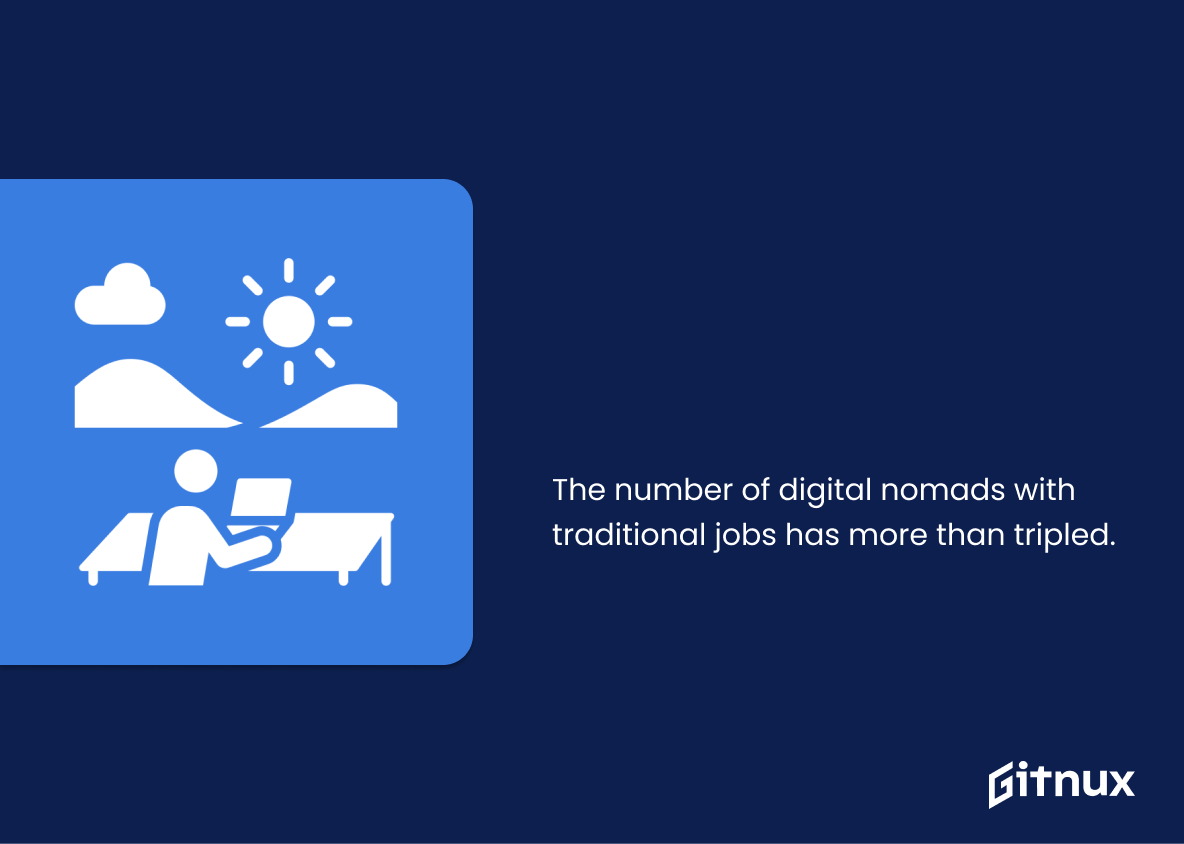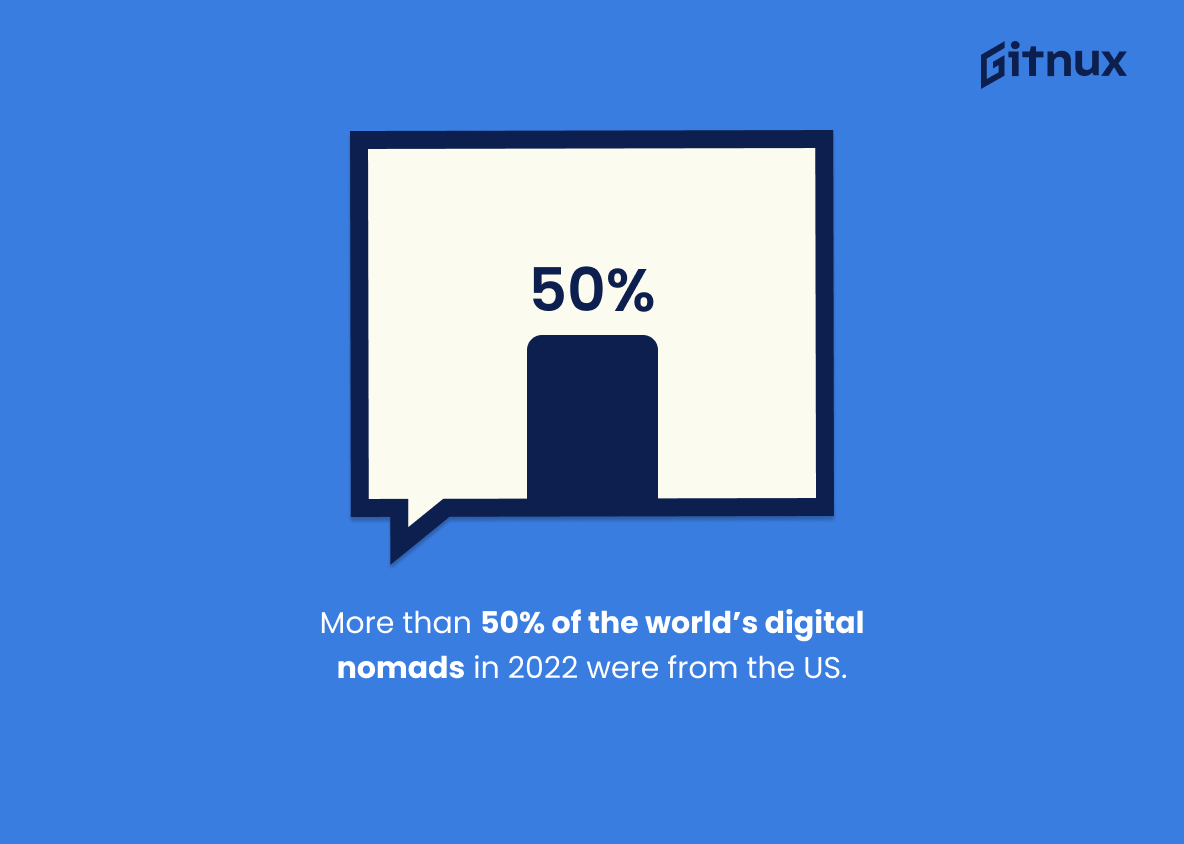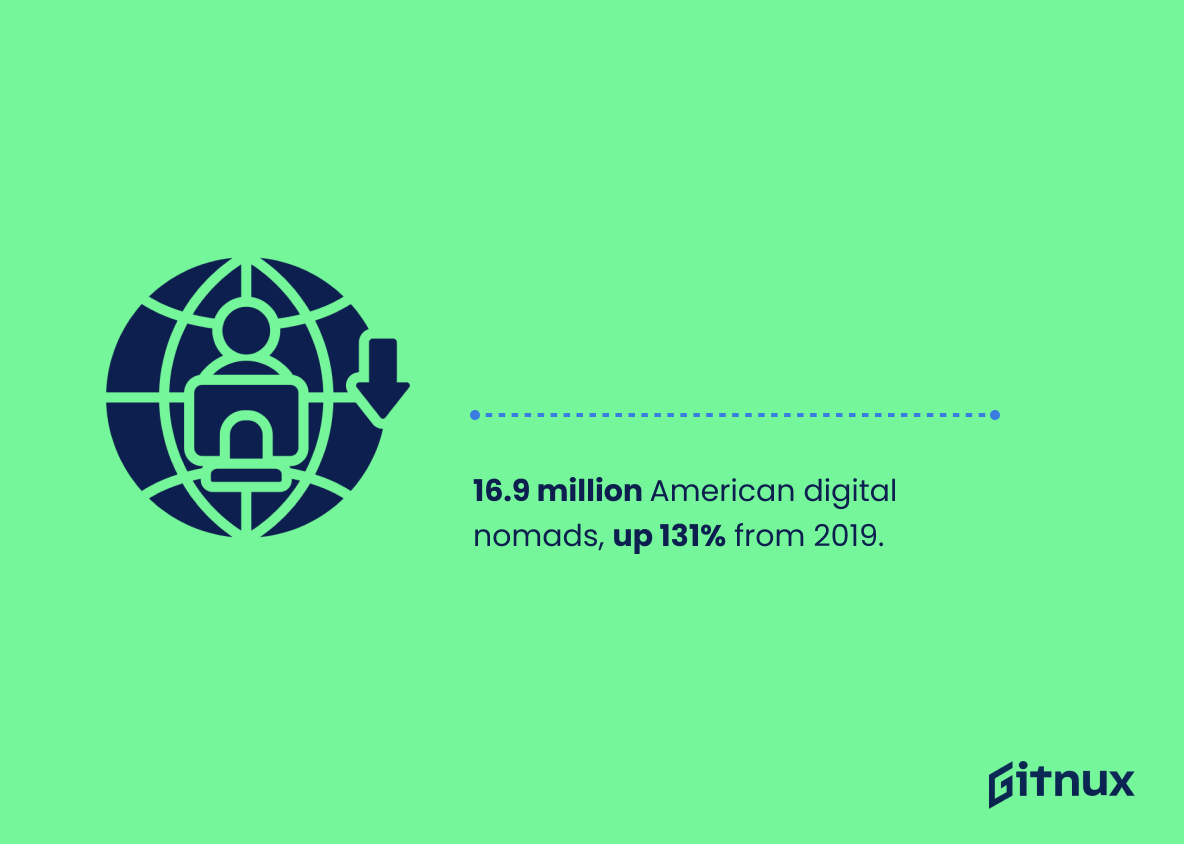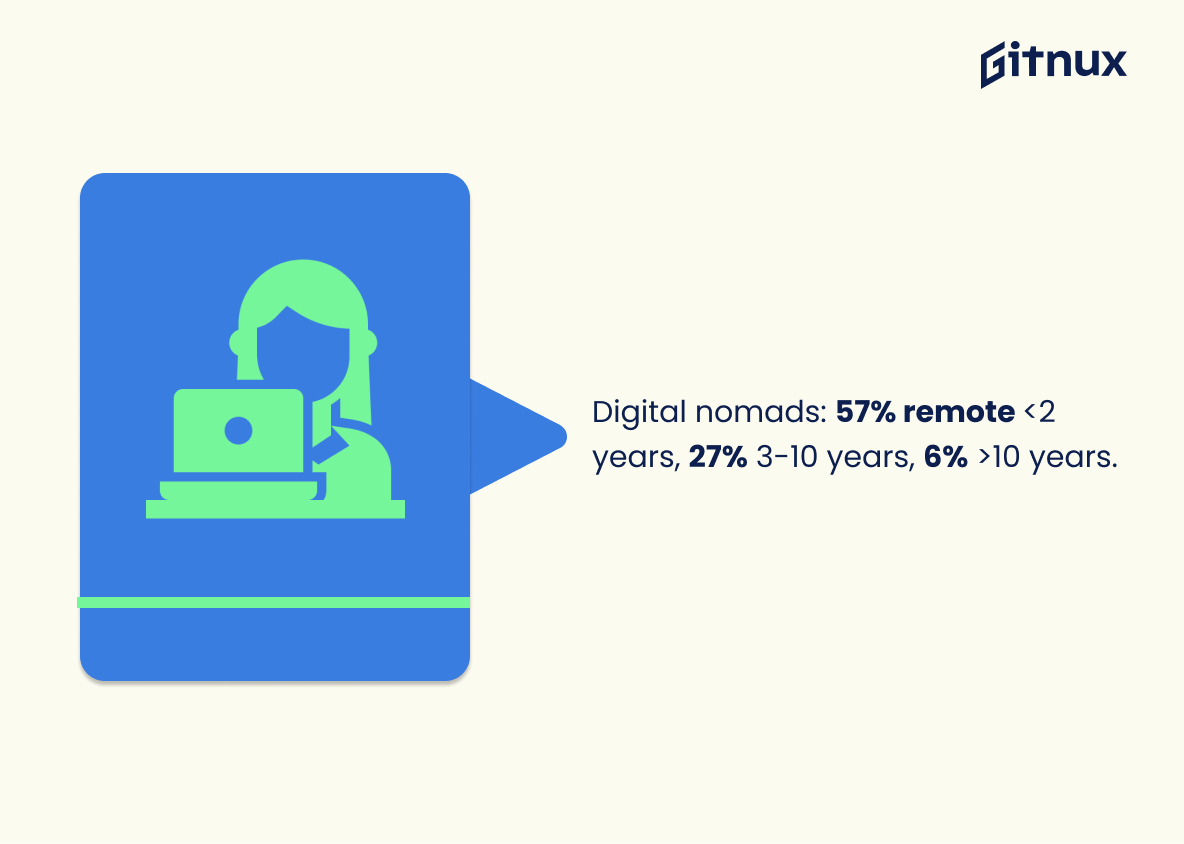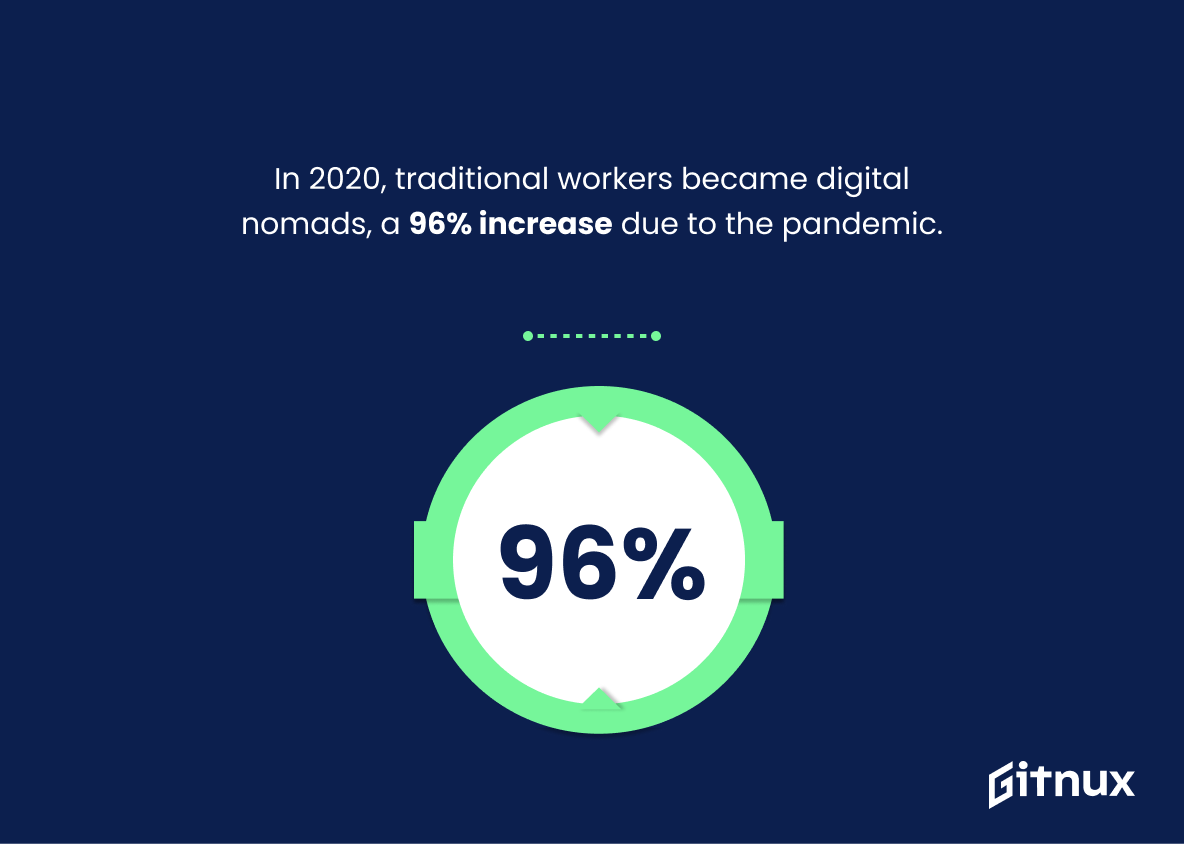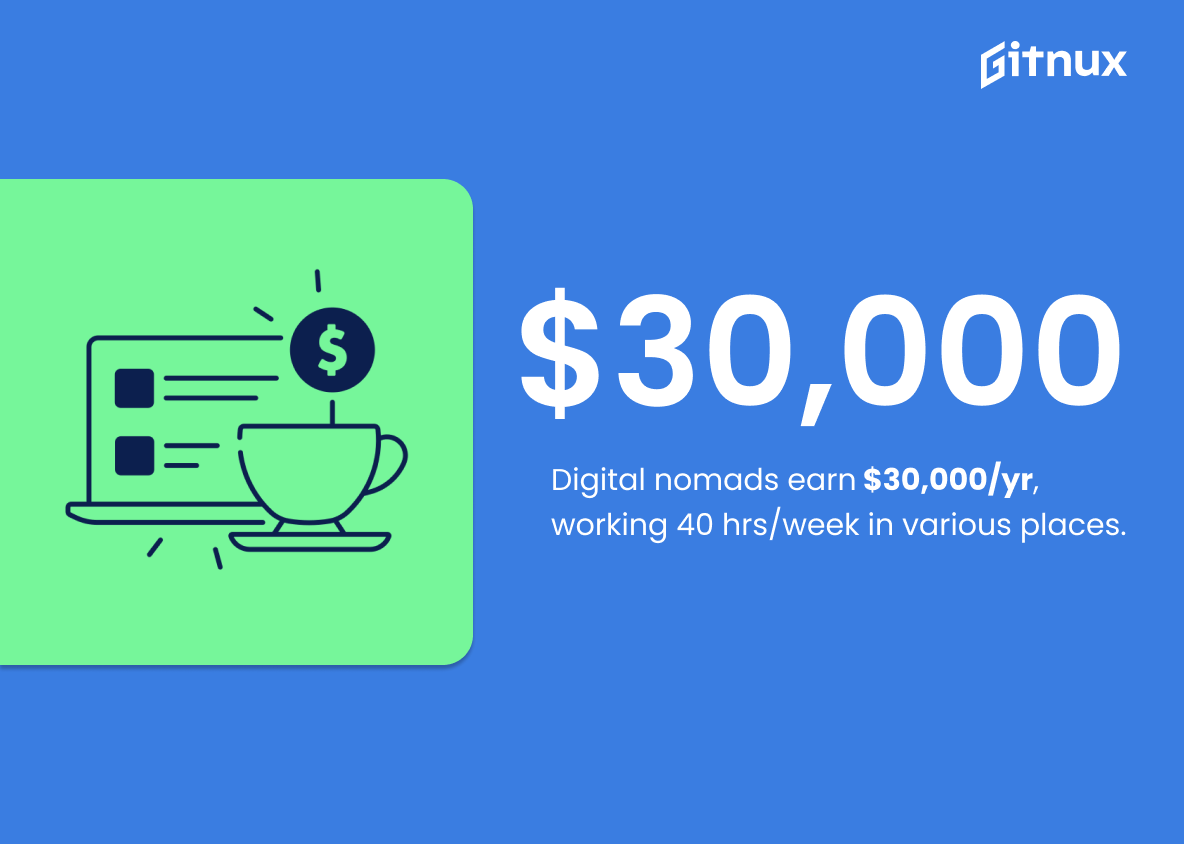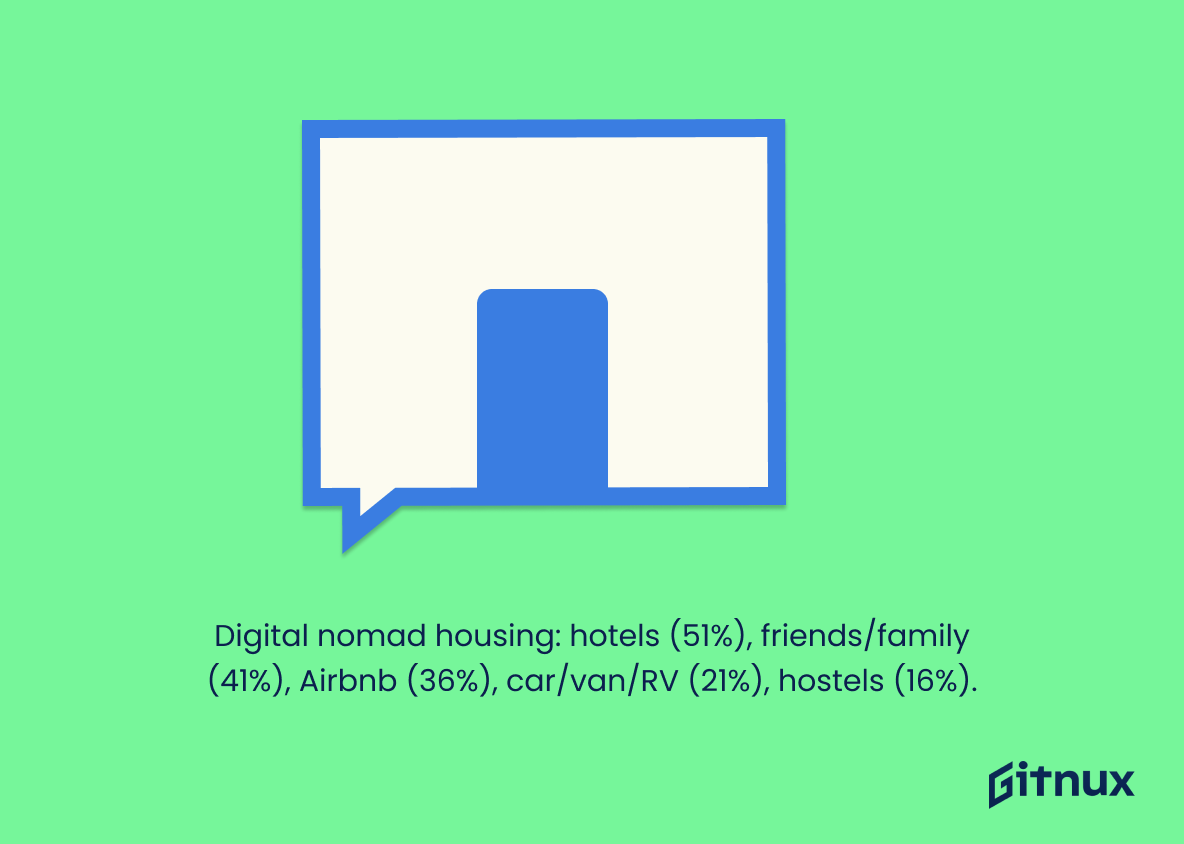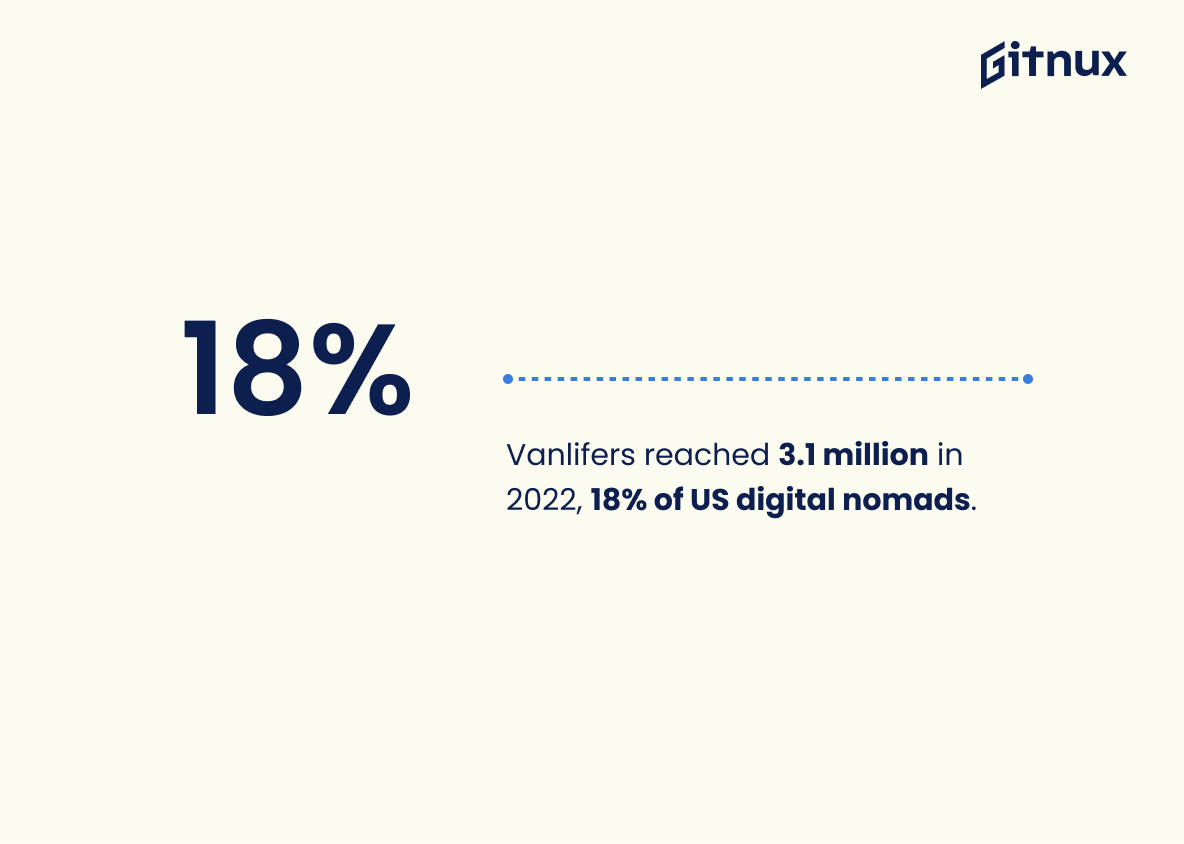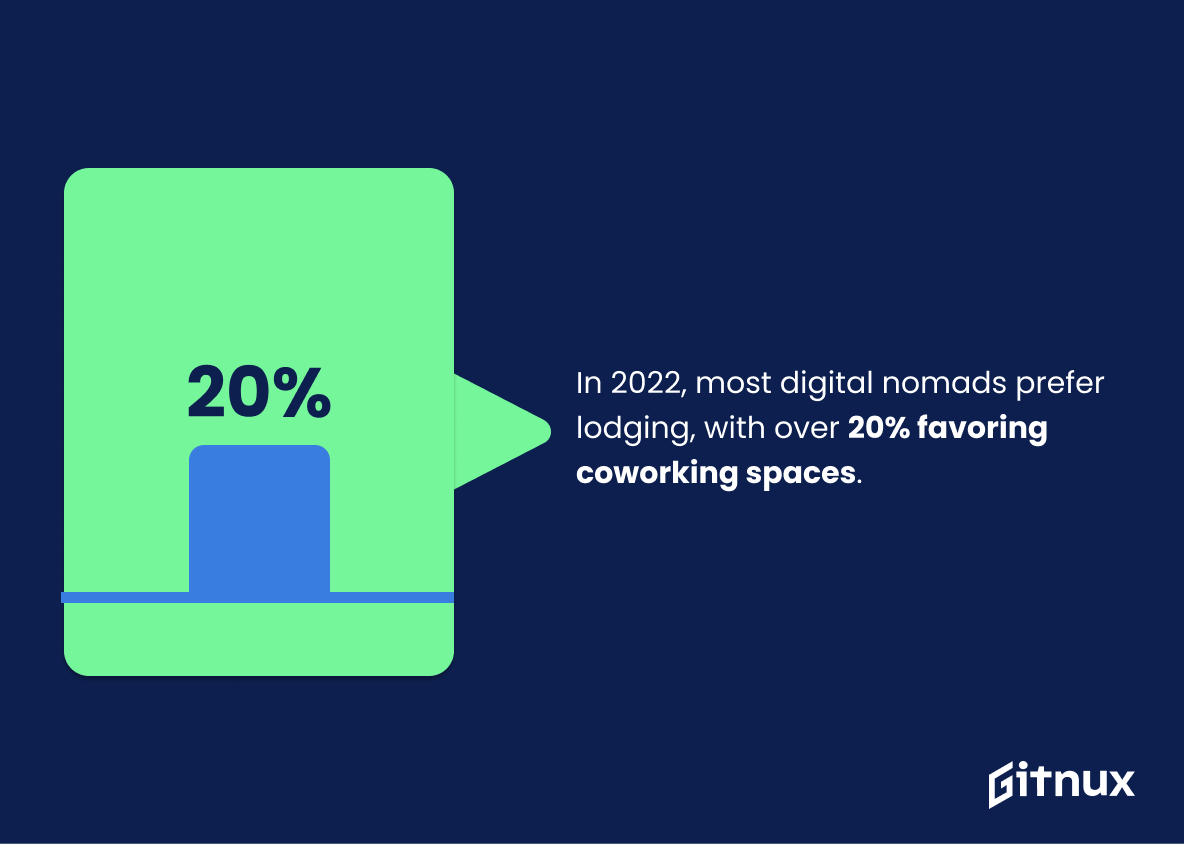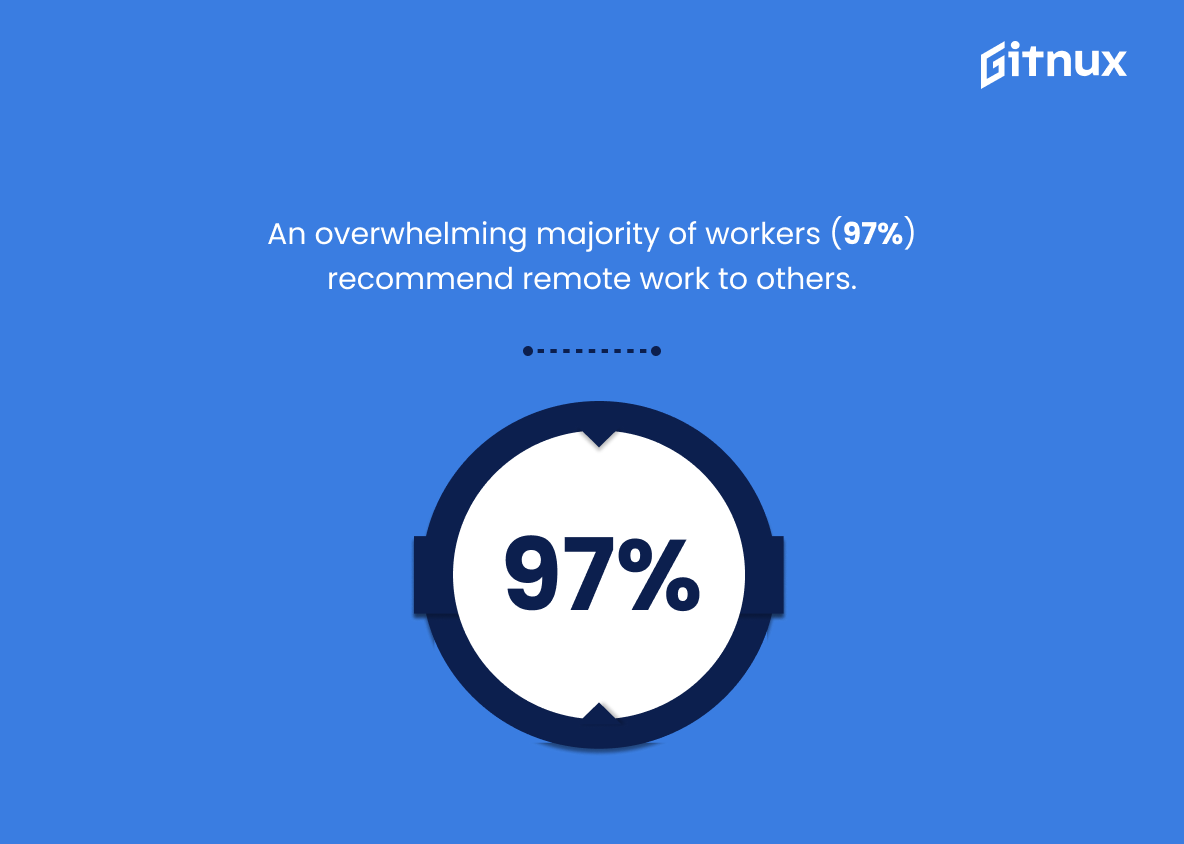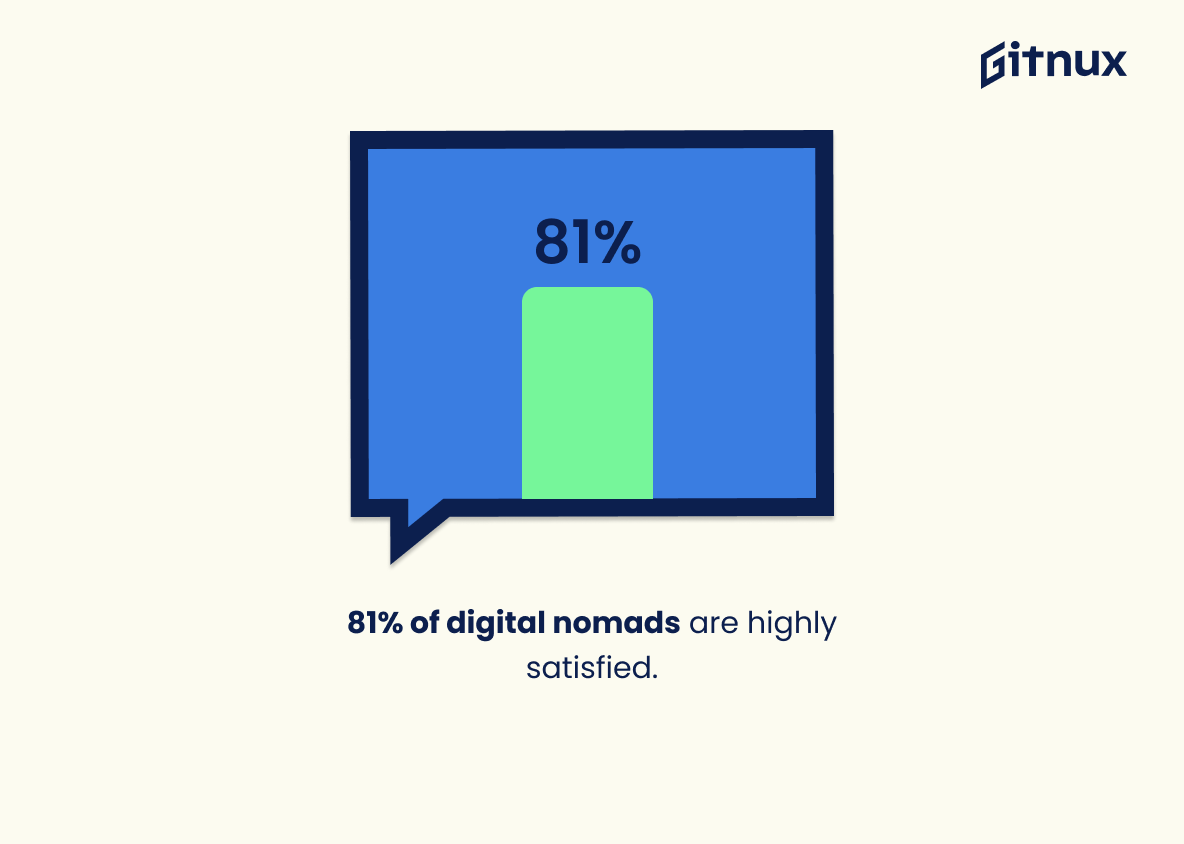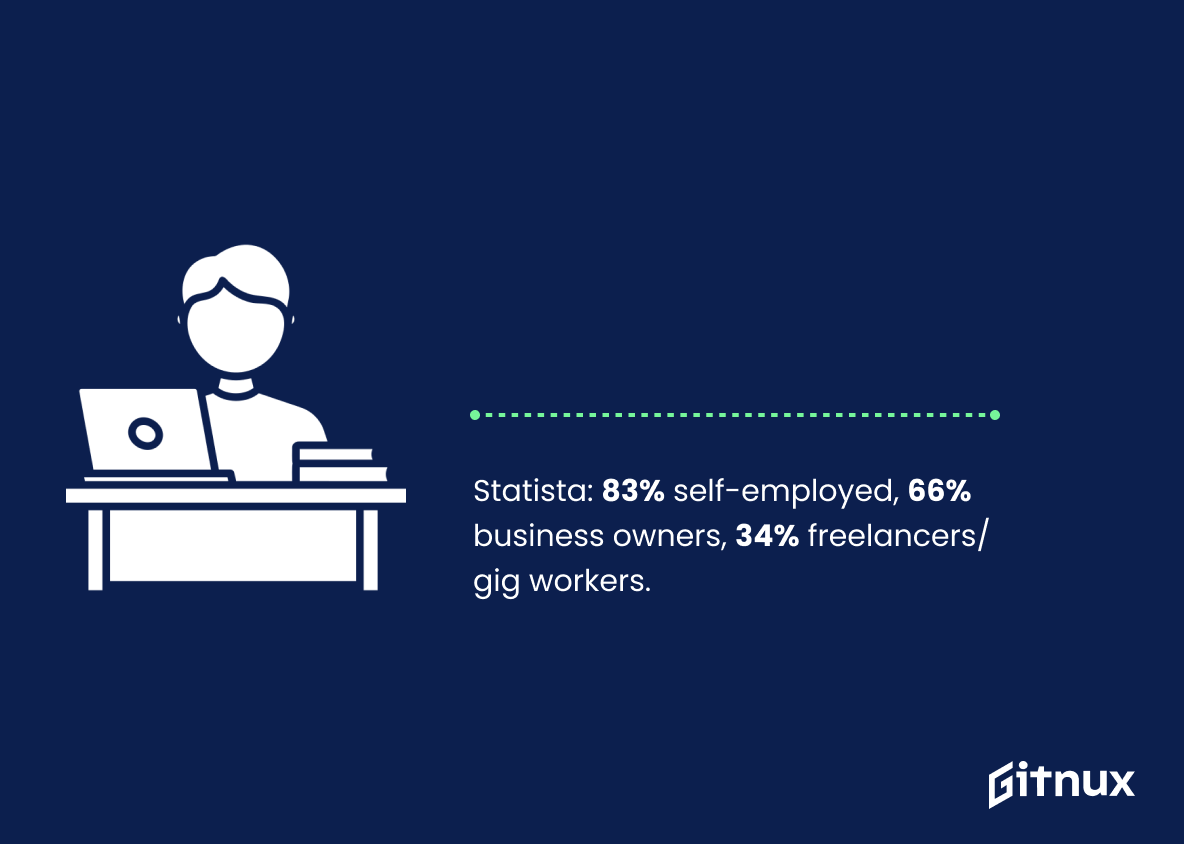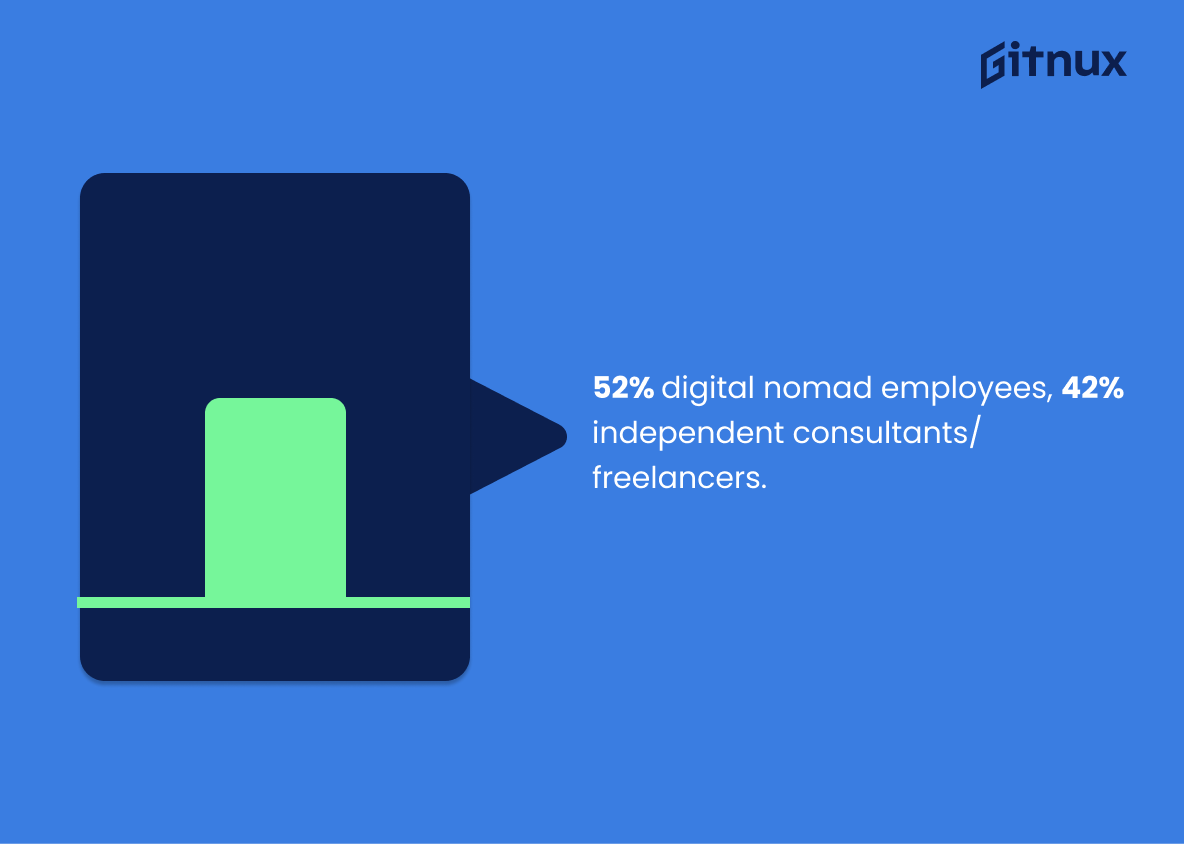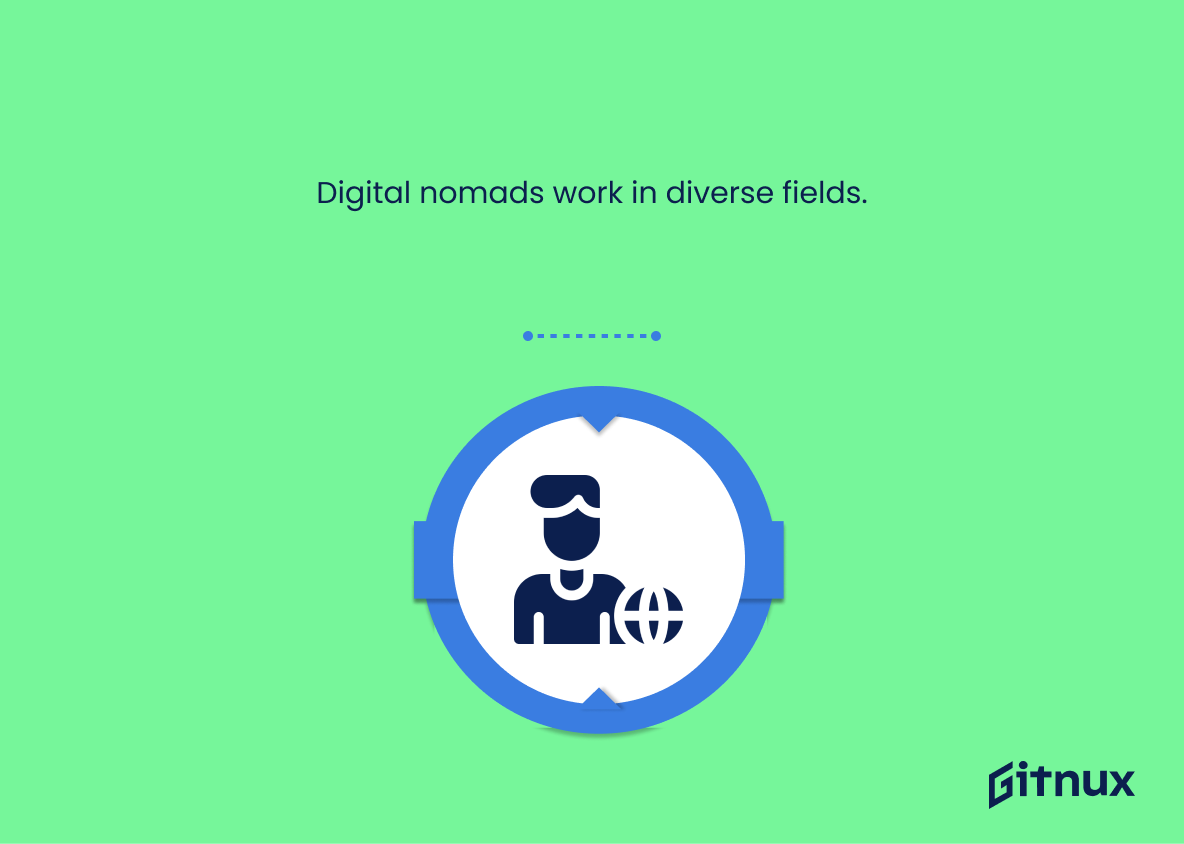Digital nomads are a growing population of people who are able to work remotely from anywhere in the world. With the rise of technology, more and more people are taking advantage of the opportunity to work remotely and live a more flexible lifestyle.
In this article, we will explore the digital nomad statistics, from their age and gender to their preferred locations and industries. We will also look at how digital nomads are impacting the global economy and how their lifestyle is changing the way we work. So, if you are curious about the digital nomad lifestyle, stay tuned to find out more.
Digital Nomads: The Most Important Statistics
- Since the start of the pandemic, the number of digital nomads with traditional jobs has more than tripled.
- The top two benefits of being a digital nomad are flexibility in how you spend your time (67%) and flexibility to choose your work location (62%).
- Over 45 countries have created digital nomad visas and other programs to smooth out the red tape, making it easier for digital nomads to locate in their countries.
General digital nomad statistics
Since the start of the pandemic, the number of digital nomads with traditional jobs has more than tripled.
More than 50% of the world’s digital nomads in 2022 were from the US.
16.9 million American workers currently describe themselves as digital nomads, increasing a staggering 131% from the pre-pandemic year 2019.
A majority of digital nomads (57%) have been working remotely for 2 years or fewer, 27% for 3 to 10 years, and 6% have worked remotely for more than 10 years.
In 2020, due to the Coronavirus pandemic, the number of traditional workers operating as digital nomads grew 96% (from 3.2 million to 6.3 million).
The average salary of digital nomads is yearly 30,000 USD. They are working approximately 40 hours per week. Mostly, digital nomads work from hotels/hostels (46%), coffee shops (45%), Airbnb (27%), or a library (20%).
The US makes up 48% of digital nomads worldwide, followed by UK (7%), Russia (5%), Canada (4%), Germany (4%), France (3%), Australia (2%), Brazil (2%), Netherlands (2%), and Spain (2%).
Nomad List
The majority of digital nomads live in hotels (51%), then with friends/family (41%), Airbnb (36%), car/van/RV (21%), and hostels (16%).
The number of vanlifers grew to 3.1 million in 2022, making up 18% of American digital nomads.
In 2022 a majority of digital nomads would rather work from home or another place of lodging than from any other location. Additionally, more than 20% of digital nomads prefer coworking spaces.
An overwhelming majority of workers (97%) recommend remote work to others.
86% of digital nomads report they use technology to make themselves more competitive in their work, vs. 47% of non-digital nomads. Digital nomads are also more likely to be early adopters of technology (74%) than non-digital nomads (42%).
According to the MBO Partners report, 81% of digital nomads are highly satisfied and 11% satisfied with their work and lifestyle. This compares to 68% of non-digital nomads reporting being highly satisfied and 14% satisfied with their work and lifestyle.
Employment types and main professions of digital nomads
83% of digital nomads are self-employed, 66% are business owners, 34% are freelancers or gig workers, and 17% are hired by a firm, according to Statista.
According to Buffer’s survey, conducted among people from 16 different countries, 52% of digital nomads are employees, while 42% are independent consultants or freelancers. Of the employees, 74% work in companies with 500 or fewer people.
Digital nomads work in a wide variety of fields, with the main professions including information technology (21%), creative services (12%) education and training (11%), sales, marketing, and PR (9%), finance and accounting (9%), and consulting, coaching and research (8%).
A high amount of male digital nomads are employed in the digital sector, with more than 30% of them working as software developers.
Many women who are digital nomads are employed in the marketing or creative industries. Furthermore, startup entrepreneurs made up about 15% of female digital nomads.
As reported by Nomad List, 44% of digital nomads are full-time employees, 17% are freelancers, 16% are startup founders, 7% are full-time contractors, and 7% work for agencies.
Digital nomad demographics
Nearly half of all digital nomads worldwide are in their 30s, according to Statista. The survey also showed that the age range of 40-59 was well-represented, making up 35% of digital nomads globally.
The younger generations, Gen Z (17%) and Millennials (47%), comprise most digital nomads, as they generally have more location flexibility due to their life stage. Gen X’s share stayed stable in 2022 at 23%.
Overall, digital nomads have gotten younger over the past 4 years. But older age groups continue to be well represented, with 37% coming from the two older generations and almost 9% older than 60.
37% of digital nomads identify as female, 61% as male, and 1% as non-binary. Further, 21% identify as of Hispanic / Latino / Spanish origin, 16% as Black or African American, and 60% as white. 10% preferred not to disclose their racial identity.
6% identified as having a chronic disability or illness, and 38% identified as parents or guardians.
According to FlexJobs, 72% of digital nomads have at least a bachelor’s degree and 33% have a master’s degree.
As stated by Nomad List, 52% of digital nomads are men, and 48% are women.
56% of all digital nomads are married, but there are big differences in the marriage rate between digital nomads with traditional jobs and independent workers. Nearly two-thirds of digital nomads with traditional jobs are married, while only about one-third (37%) of independent workers are married.
Benefits of being a digital nomad
The ability to have a flexible schedule was cited as the top perk of working remotely by 67% of Statista survey respondents in 2022. The ability to work from anywhere came in second (62%), followed by having less commuting time (59%), more financial freedom (48%), improved focus (44%), and a sense of security (32%).
According to Buffer’s research, the top two benefits of being a digital nomad are flexibility in how you spend your time (67%) and flexibility to choose your work location (62%).
44% of respondents with a chronic disability or illness cited their personal circumstances as a reason they pursued the flexibility of remote work, and 76% of working parents/guardians said the same thing.
The top benefits of being a digital nomad are a flexible schedule (85%), no commuting (65%), freedom to live and work where you choose (65%), work-life balance (63%), no office politics (52%), and no dress code (51%).
FlexJobs
The top factors for wanting to be a digital nomad, according to Flexjobs, are: work-life balance (73%), enjoying freedom (68%), love to travel (55%), avoiding office politics and distractions of a traditional work environment (43%), opportunity to explore other cultures (37%), high cost of living in home country (30%), and the poor local job market in hometown (24%).
Common challenges digital nomads may encounter
The main struggles of being a digital nomad are unplugging (25%) and loneliness (24%), according to Buffer’s report.
The top challenges reported by current digital nomads are personal safety (34%), being away from family and friends (32%), time zone differences making work difficult (30%), loneliness (26%), travel logistics (25%) and managing work and travel (25%).
MBO Partners asked former digital nomads why they discontinued this lifestyle, and their answers echoed the challenges reported by current nomads. The top three reasons are: they got tired of travelling, it was too expensive, and the logistics were too challenging. Other reasons included loneliness, difficulties combining work and full-time travel, and missing family and friends.
The top challenges of being a digital nomad, according to the FlexJobs survey, are finding reliable Wi-Fi (52%), finding a good place to work (42%), networking (35%), time zones (29%), and work communications (20%).
9% of self-employed individuals struggle with distractions and staying motivated. They also have to deal with loneliness (33%), overworking (33%), career progressions (25%), and contacting their coworkers in various time zones (20%).
Best locations for digital nomads to explore
Over 45 countries have created digital nomad visas and other programs to smooth out the red tape, making it easier for digital nomads to locate in their countries.
Germany gives digital nomads the visa with the longest validity.
Other countries that offer a form of digital nomad visas include Australia, Czech Republic, UAE, Estonia, Thailand, Indonesia, Italy, Spain and Brazil, among many others.
Thailand leads as the world’s top country for digital nomads, according to Club Med research.
Bangkok (the capital of Thailand) is ranked as the leading city destination for a workation (a trip where people travel to a new destination and work from there) worldwide in 2021.
The top places digital nomads travel to are America (53%), Western Europe (18%), and Asia (13%).
The vast majority of digital nomads (71%) visits 1-2 countries in a year, 19% go to 3-4 countries, and around 8% manage to visit more than 5 countries.
The future of the digital nomad workforce
Employees typically view remote work as the future of work, since it allows them to remain productive while completing their tasks. Over 60% of respondents said they would think about switching from their co-located employer to a remote position.
73 million of adult Americans who aren’t digital nomads plan or think of becoming digital nomads over the next 2-3 years. This is a 12% increase compared to 2021.
71% of digital nomads report planning to continue as digital nomads for at least the next 2 to 3 years.
Vanlifers is the fastest-growing digital nomad segment. They travel, live, and work in RVs, vans, or other vehicles converted into roaming residences. Vanlifers’ lifestyle are on the rise, increasing by 19% in 2022 and reaching 3.1 million. The pandemic clearly accelerated the growth of the vanlife trend.
Supplementary Statistics
4.8 million Americans identify as digital nomads.
More and more people are embracing the lifestyle of working remotely and taking advantage of the freedom and flexibility it offers. It also speaks to the potential of digital nomadism as a viable career option for those looking to break away from the traditional 9-5.
The digital nomad population has grown by 49% since 2019.
More and more people are embracing the lifestyle of working remotely and taking advantage of the freedom and flexibility it offers. This growth in the digital nomad population is indicative of a larger trend towards remote work and a more mobile lifestyle.
1 out of 4 employees are considering becoming digital nomads post-pandemic.
A significant portion of the workforce is open to the idea of embracing the digital nomad lifestyle, which could lead to a surge in the number of people taking advantage of the freedom and flexibility that comes with it.
74% of digital nomads are under the age of 41.
The majority of digital nomads are relatively young. This is important to consider when discussing digital nomad statistics, as it provides insight into the lifestyle choices of a younger generation.
By 2035, the number of digital nomads is expected to reach 1 billion.
It speaks to the increasing number of people who are choosing to live and work remotely, taking advantage of the freedom and flexibility that comes with it. It also highlights the potential of digital nomadism as a viable career option, and the potential for it to become a major part of the global economy in the near future.
67% of digital nomads have a bachelor’s degree or higher.
Digital nomads are a highly skilled and educated group of people, and should be taken into account when discussing the digital nomad lifestyle.
54% of digital nomads are male.
Digital nomadism is not a gender-neutral lifestyle, and that there are still many challenges to be faced in order to make it more accessible to all.
There are more than 18,000 registered digital nomad companies worldwide.
Digital nomadism is a rapidly growing phenomenon, with thousands of companies around the world offering services to digital nomads. This statistic is a powerful indicator of the potential of digital nomadism as a viable career option for those looking to work remotely.
Only 31% of digital nomads have children.
The majority of digital nomads do not have children. This can be indicative of the fact that digital nomads are more likely to be young, single, and without dependents, allowing them to travel and work freely. It also suggests that digital nomads may be more likely to prioritize their career and lifestyle over starting a family. This information can be useful for those considering a digital nomad lifestyle, as it provides insight into the type of lifestyle they may be able to expect.
59% of companies today support workers who telecommute or work remotely.
More and more businesses are recognizing the potential benefits of allowing their employees to work from anywhere, which is a major draw for digital nomads. This statistic is a testament to the increasing popularity of the digital nomad lifestyle and the opportunities it provides.
The number of digital nomads is increasing by 18% annually.
More and more people are choosing to pursue this lifestyle. It speaks to the potential of digital nomadism as a viable career option, and the potential for growth in the industry. It also serves as a reminder that digital nomadism is becoming an increasingly attractive option for those looking to break away from the traditional 9-5 lifestyle.
Conclusion
As you can see, the digital nomad lifestyle is on the rise, with more people than ever before taking advantage of the freedom and flexibility that comes with it. The latest digital nomad statistics show us that digital nomads are highly educated and come from a variety of backgrounds and countries. They are also highly motivated, with a strong desire to work and travel at the same time. The digital nomad lifestyle is a great way to explore the world, gain valuable experiences, and make a living at the same time.
Resources
Buffer: “2022 State Of Remote Work”, cited January 2023. (Source)
Club Med: “Top countries for digital nomads: Where to work while travelling in 2021”, cited January 2023. (Source)
FlexJobs: “FlexJobs Digital Nomad Survey: Insights into the Remote Lifestyle”, cited January 2023. (Source)
Harvard Business Review: “How “Digital Nomad” Visas Can Boost Local Economies”, cited January 2023. (Source)
MBO Partners: “COVID-19 and the Rise of the Digital Nomad”, cited January 2023. (Source)
MBO Partners: “The Aspirations and Reality for Digital Nomads”, cited January 2023. (Source)
Nomad List: “The 2023 State of Digital Nomads”, cited January 2023. (Source)
Project Untethered: “NEW Digital Nomad Statistics & Trends + Infographic [2023 Update]”, cited January 2023. (Source)
Statista: “Attitudes on remote work for employees worldwide from 2020 to 2021, by category”, cited January 2023. (Source)
Statista: “Leading cities for remote working (“workations”) worldwide in 2021, by Holidu index score”, cited January 2023. (Source)
Statista: “Leading occupations of female digital nomads worldwide as of March 2022”, cited January 2023. (Source)
Statista: “Leading occupation of male digital nomads worldwide as of March 2022”, cited January 2023. (Source)
Statista: “Number of countries granting visas to digital nomads worldwide in 2022, by region”, cited January 2023. (Source)
Statista: “Preferred workplaces for digital nomads worldwide in 2022”, cited January 2023. (Source)
Statista: “Share of digital nomads worldwide as of March 2022, by education level”, cited January 2023. (Source)
Statista: “Share of digital nomads worldwide as of March 2022, by nationality”, cited January 2023. (Source)
Statista: “Share of digital nomads worldwide in 2022, by age”, cited January 2023. (Source)
Statista: “Share of digital nomads worldwide in 2022, by type of employment”, cited January 2023. (Source)
Statista: “What’s the biggest benefit you see to working remotely?”, cited January 2023. (Source)
ThinkRemote: “30+ Amazing Digital Nomad Stats, Trends and Facts 2022”, cited January 2023. (Source)
ThinkRemote: “7 Exciting Statistics About Digital Nomads in 2022”, cited January 2023. (Source)
ZipDo, cited June 2023: Digital Nomad Statistics
